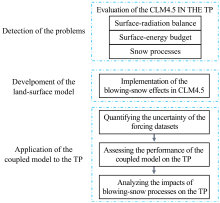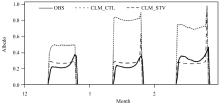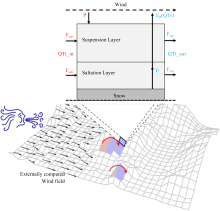Sciences in Cold and Arid Regions ›› 2019, Vol. 11 ›› Issue (5): 335–339.doi: 10.3724/SP.J.1226.2019.00335.
• • 下一篇
Origin and advances in implementing blowing-snow effects in the Community Land Model
- 1. Key Laboratory of Land Surface Process and Climate Change in Cold and Arid Regions, Northwest Institute of Eco‐Environment and Resources, Chinese Academy of Sciences, Lanzhou, Gansu 730000, China
2. Key Laboratory of Tibetan Environment Changes and Land Surface Processes, Institute of Tibetan Plateau Research, Chinese Academy of Sciences, Beijing 100085, China
3. CAS Center for Excellence in Tibetan Plateau Earth Sciences, Beijing 100085, China
| Dickson RR , 1984. Eurasian snow cover versus Indian monsoon rainfall-An extension of the Hahn-Shukla results. Journal of Climate and Applied Meteorology, 23(1): 171-173. | |
|
Duan AM , Wu GX , 2005. Role of the Tibetan Plateau thermal forcing in the summer climate patterns over subtropical Asia. Climate Dynamics, 24(7-8): 793-807. DOI: 10.1007/s00382-004-0488-8 .
doi: 10.1007/s00382-004-0488-8 |
|
| Lai X , Wen J , Cen S , et al. , 2014. Numerical simulation and evaluation study of soil moisture over China by using CLM4.0 model. Chinese Journal of Atmospheric Sciences, 38(3): 499-512. | |
| Li H , Wang J , Hao X , 2012. Influence of blowing snow on snow mass and energy exchanges in the Qilian Mountainous. Journal of Glaciology and Geocryology, 34(5): 1084-1090. | |
|
Li H , Wang J , Hao X , 2014. Role of blowing snow in snow processes in Qilian Mountainous region. Sciences in Cold and Arid Regions, 6(2): 124-130. DOI: 10.3724/SP.J.1226. 2014.00124 .
doi: 10.3724/SP.J.1226. 2014.00124 |
|
| Liu S , Lin Z , 2005. Validation of common land model using field experiment data over typical land cover types in East Asia. Climatic and Environmental Research, 10(3): 684-699. | |
|
Manabe S , Broccoli AJ , 1990. Mountains and arid climates of middle latitudes. Science, 247(4939): 192-194. DOI: 10. 1126/science.247.4939.192 .
doi: 10. 1126/science.247.4939.192 |
|
| Wang ZL , Zhang Z , 1999. Regionalization of snow drift in China. Journal of Mountain Science, 17: 312-317. | |
|
Wei Z , Dong W , 2015. Assessment of simulations of snow depth in the Qinghai-Tibetan Plateau using CMIP5 multi-models. Arctic Antarctic and Alpine Research, 47(4): 611-625. DOI: 10.1657/aaar0014-050 .
doi: 10.1657/aaar0014-050 |
|
| Wood EF , 2012. Land Surface-Atmosphere Interactions for Climate Modeling: Observations, Models and Analysis, Springer Science & Business Media. | |
|
Wu TW , Qian ZA , 2003. The relation between the Tibetan winter snow and the Asian summer monsoon and rainfall: An observational investigation. Journal of Climate, 16(12): 2038-2051. DOI: 10.1175/1520-0442(2003)016<2038:Trbttw>2.0.Co;2 .
doi: 10.1175/1520-0442(2003)016<2038:Trbttw>2.0.Co;2 |
|
|
Xie ZP , Hu ZY , Gu LL , et al. , 2017b. Meteorological forcing datasets for blowing snow modeling on the Tibetan Plateau: Evaluation and intercomparison. Journal of Hydrometeorology, 18(10): 2761-2780. DOI: https://doi.org/10. 1175/Jhm ‐D‐170075.1.
doi: 10. 1175/Jhm |
|
|
Xie ZP , Hu ZY , Liu HL , et al. , 2017a. Evaluation of the surface energy exchange simulations of Land Surface Model CLM4.5 in alpine meadow over the Qinghai‐Xizang Plateau. Plateau Meteorology, 36(1): 1-12. DOI: 10.7522/j.issn.1000 ‐0534.2016.00012.
doi: 10.7522/j.issn.1000 |
|
| Xie ZP , Hu ZY , Ma YM , et al. , 2019. Modeling blowing snow over the Tibetan Plateau with the Community Land Model: Method and preliminary evaluation. Journal of Geophysical Research: Atmospheres, 124: 9332-9355. . | |
| Xie ZP , Hu ZY , Xie ZH , et al. , 2018. Impact of the snow cover scheme on snow distribution and energy budget modeling over the Tibetan Plateau. Theoretical and Applied Climatology, 131(3-4): 951-965. . | |
|
Yanai MH , Li CF , Song ZS , 1992. Seasonal heating of the Tibetan Plateau and its effects on the evolution of the Asian Summer Monsoon. Journal of the Meteorological Society of Japan, 70(1B): 319-351. DOI: 10.2151/jmsj1965.70. 1B_319 .
doi: 10.2151/jmsj1965.70. 1B_319 |
|
| Yang S , 1996. ENSO-snow-monsoon associations and seasonal-interannual predictions. International Journal of Climatology: A Journal of the Royal Meteorological Society, 16(2): 125-134. | |
| Yang ZL , 2004. Modeling land surface processes in short-term weather and climate studies. Observation, Theory and Modeling of Atmospheric Variability. World Scientific Series on Meteorology of East Asia. New Jersey: World Scientific, 288-313. | |
| Ye D , Gao Y , 1979. The Meteorology of the Qinghai-Xizang (Tibet) Plateau. In: Science Press, Beijing, pp. 1-278. | |
|
Zhao P , Xu X , Chen F , et al. , 2018. The third atmospheric scientific experiment for understanding the Earth-Atmosphere Coupled System over the Tibetan Plateau and its effects. Bulletin of the American Meteorological Society, 99(4): 757-776. DOI: 10.1175/bams-d-16-0050.1 .
doi: 10.1175/bams-d-16-0050.1 |
| No related articles found! |







